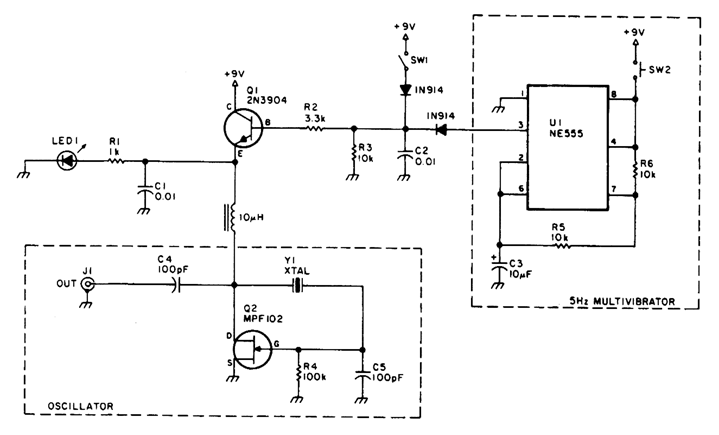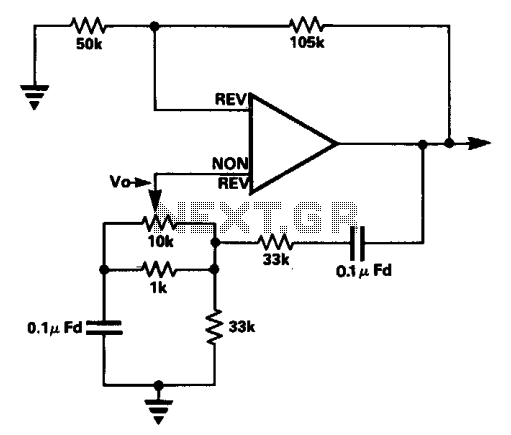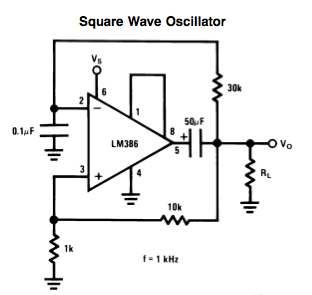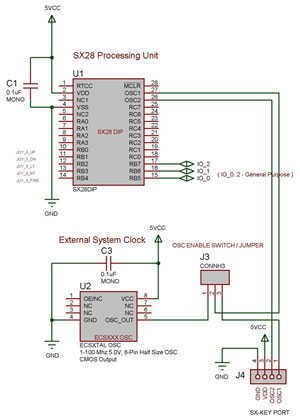
SHORTWAVE PULSED MARKER OSCILLATOR

A marker oscillator can be constructed using an NE555 timer to generate pulses at an audio frequency. This design facilitates the identification of signals amidst interference. The oscillator can utilize a crystal with a frequency ranging from 1 to 30 MHz.
The NE555 timer is a versatile integrated circuit widely used for generating precise timing and oscillation. In this application, it operates in astable mode, where it continuously switches between high and low states, generating a square wave output. The frequency of oscillation is determined by the external resistors and capacitor connected to the NE555.
To set the desired frequency, a crystal oscillator can be employed, which provides stability and precision. The frequency range of 1 to 30 MHz allows for flexibility in applications, making it suitable for various electronic projects. The inclusion of a crystal ensures that the output frequency remains consistent, which is crucial for accurate signal identification.
The circuit typically consists of the NE555 timer, a crystal oscillator, and passive components such as resistors and capacitors. The output can be connected to an audio amplifier or a speaker to produce audible tones, aiding in the detection of signals. Additionally, the circuit can be designed to include a variable resistor, allowing for frequency adjustment within the specified range.
Overall, this marker oscillator design using the NE555 timer is an effective solution for generating stable audio signals, enhancing the ability to locate and analyze signals in the presence of noise or interference.A useful marker oscillator can be made using an NE555 to pulse the oscillator at an audio rate. This makes it easy to find the signal in the presence of interference. The crystal can be any suitable frequency from 1 to 30 MHz. 🔗 External reference
The NE555 timer is a versatile integrated circuit widely used for generating precise timing and oscillation. In this application, it operates in astable mode, where it continuously switches between high and low states, generating a square wave output. The frequency of oscillation is determined by the external resistors and capacitor connected to the NE555.
To set the desired frequency, a crystal oscillator can be employed, which provides stability and precision. The frequency range of 1 to 30 MHz allows for flexibility in applications, making it suitable for various electronic projects. The inclusion of a crystal ensures that the output frequency remains consistent, which is crucial for accurate signal identification.
The circuit typically consists of the NE555 timer, a crystal oscillator, and passive components such as resistors and capacitors. The output can be connected to an audio amplifier or a speaker to produce audible tones, aiding in the detection of signals. Additionally, the circuit can be designed to include a variable resistor, allowing for frequency adjustment within the specified range.
Overall, this marker oscillator design using the NE555 timer is an effective solution for generating stable audio signals, enhancing the ability to locate and analyze signals in the presence of noise or interference.A useful marker oscillator can be made using an NE555 to pulse the oscillator at an audio rate. This makes it easy to find the signal in the presence of interference. The crystal can be any suitable frequency from 1 to 30 MHz. 🔗 External reference





